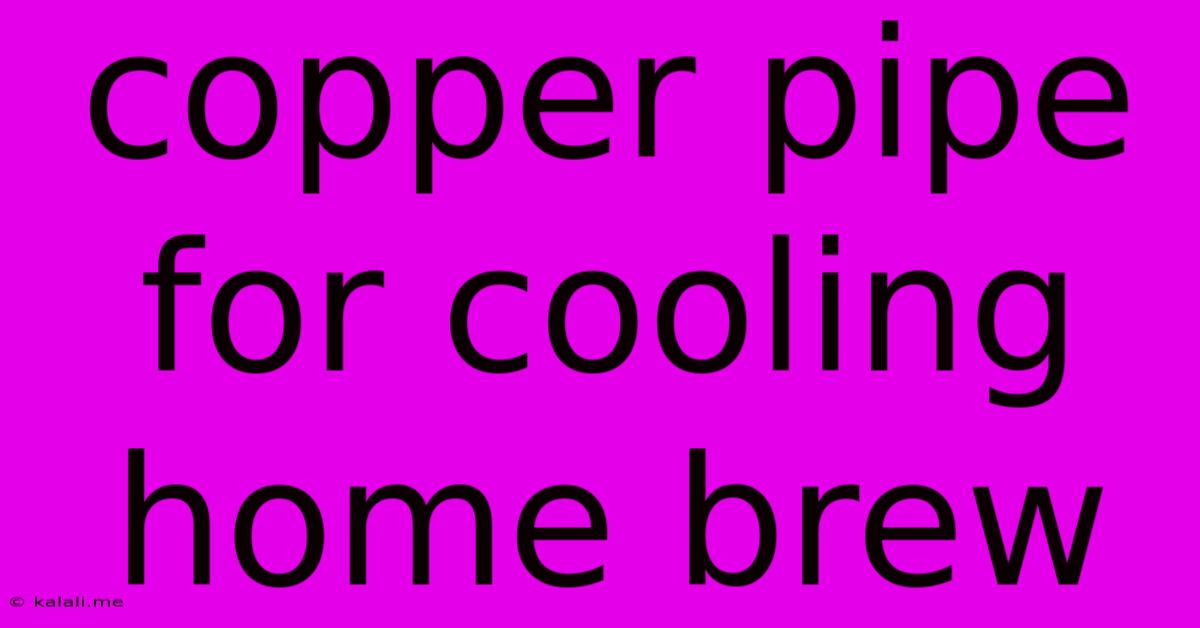Copper Pipe For Cooling Home Brew
Kalali
May 19, 2025 · 3 min read

Table of Contents
Copper Pipe for Cooling Homebrew: A Comprehensive Guide
Meta Description: Learn how to effectively use copper pipe for chilling your homebrew, improving efficiency and preserving flavor. This guide covers the methods, benefits, and potential drawbacks of using copper chilling coils.
Homebrewing is a rewarding hobby, but efficiently cooling your wort (unfermented beer) after the boil is crucial for preventing unwanted bacteria growth and preserving the quality of your final product. While immersion chillers and counter-flow chillers are popular choices, using copper pipe offers a unique and effective method with potential cost advantages. This article delves into the intricacies of utilizing copper pipe for cooling your homebrew.
Why Choose Copper Pipe for Cooling?
Copper possesses several properties that make it ideal for homebrew chilling:
- Excellent Heat Conductivity: Copper's high thermal conductivity allows for rapid heat transfer, significantly reducing the cooling time compared to other materials. This minimizes the risk of bacterial contamination during the critical cooling phase.
- Durability and Longevity: A well-constructed copper chiller will last for many years, providing a long-term investment in your homebrewing setup.
- Sanitization: Copper is relatively easy to sanitize, vital for maintaining the hygiene of your brewing process. Proper cleaning and sanitizing protocols are, however, essential.
- Cost-Effectiveness: While initial material costs might vary, the longevity of copper pipes often makes it a cost-effective solution in the long run compared to replacing disposable chillers.
Constructing Your Copper Chiller Coil
Building your own copper chiller coil requires some basic plumbing skills and tools. You'll need:
- Copper Pipe: The diameter and length will depend on your brewing system's volume and desired cooling speed. 1/2" or 3/8" diameter pipe is commonly used.
- Pipe Cutter: For cleanly cutting the copper pipe to the desired length.
- Pipe Bender: Essential for creating the coil shape. A spring-type bender is recommended for cleaner bends.
- Soldering Equipment (Optional): If you're creating a more complex coil design, soldering might be necessary to connect different sections.
- Fittings (Optional): Depending on your chosen design, you may need fittings to connect the coil to your brewing system.
Different Copper Chiller Designs
There are two primary designs for copper chillers:
- Immersion Chiller: This simple design involves a coiled copper pipe immersed directly in the wort. The wort flows around the coil, allowing for efficient heat transfer. This is a popular choice for its simplicity and effectiveness.
- Counter-Flow Chiller: More complex, a counter-flow chiller involves two separate copper pipes running parallel to each other. The wort flows through one pipe while chilled water flows through the other, resulting in even more efficient cooling due to the counter-current flow.
Advantages and Disadvantages
Advantages:
- Speed: Significantly faster cooling than some other methods.
- Efficiency: Optimized heat transfer results in less water waste.
- Durability: Long-lasting investment for your brewing setup.
- Relatively Inexpensive: Can be cheaper in the long run compared to disposable chillers.
Disadvantages:
- Requires Skill: Constructing a chiller requires some DIY skills.
- Potential for Leaks: Improper construction can lead to leaks.
- Maintenance: Regular cleaning and sanitization are essential.
Cleaning and Sanitizing Your Copper Chiller
Maintaining cleanliness is paramount. Always thoroughly clean and sanitize your copper chiller after each use to prevent bacterial contamination. Appropriate sanitation solutions for homebrewing are recommended.
Conclusion
Using copper pipe for chilling your homebrew provides a robust, efficient, and potentially cost-effective solution. While it requires some initial effort in construction, the rewards of faster cooling times and a high-quality final product make it a worthwhile investment for the dedicated homebrewer. Remember to prioritize safety and follow proper cleaning and sanitization procedures.
Latest Posts
Latest Posts
-
Can You Use Normal Pans On Induction Hobs
May 19, 2025
-
Can You See The Milky Way With The Naked Eye
May 19, 2025
-
Difference Between A Labyrinth And A Maze
May 19, 2025
-
What Time Do You Call This
May 19, 2025
-
Why Is Potassium More Reactive Than Lithium
May 19, 2025
Related Post
Thank you for visiting our website which covers about Copper Pipe For Cooling Home Brew . We hope the information provided has been useful to you. Feel free to contact us if you have any questions or need further assistance. See you next time and don't miss to bookmark.